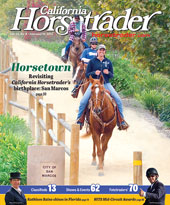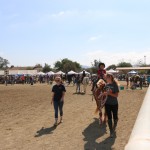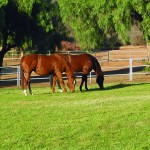 SAN MARCOS — Times are challenging for horse people in desireable places with natural beauty, accessiblity and a perfect climate. Competition for land and local government attention can be brutal as population increases while available property does not. Some California horsetowns are seeing a reduction in equine activities, and even less people owning horses within the community. But in the San Diego County town of San Marcos, horses still reign supreme.
SAN MARCOS — Times are challenging for horse people in desireable places with natural beauty, accessiblity and a perfect climate. Competition for land and local government attention can be brutal as population increases while available property does not. Some California horsetowns are seeing a reduction in equine activities, and even less people owning horses within the community. But in the San Diego County town of San Marcos, horses still reign supreme.
One reason for San Marcos stability as a horse community is the dedication of horse people within the Twin Oaks Valley, the northernmost section of town. Equestrian properties line the nearly 10-mile long Twin Oaks Valley Road, and are thriving.
Horsey Past
San Marcos’ equine roots go back to the Mission era, when the San Luis Rey Mission lands occupied much of Northern San Diego County. The fathers of the mission raised livestock and came to have 2,000 head of horses, which grazed the rolling hillsides.
The land changed hands several times after the Mexican government took over the California missions. In the early 1860s, Major Gustavus French Merriam, a pioneer from Topeka, Kansas, homesteaded 160 acres in the northern section of the Twin Oaks Valley. Here he produced wine and honey.
German and Dutch immigrants soon followed, and the first town in the area was established just south of the settlement. Called Barham after the man who founded it, the town boasted a post office, blacksmith, feed store and weekly newspaper. In 1887, the San Marcos Land Company purchased nearly all the land in the area and divided it into tracts. The hamlet of Barham soon became the town of San Marcos, and stayed small until 1956, when water from the Colorado River was diverted to the area. The population began to grow, and in the 1980s, reached 33,000. Today, San Marcos has nearly 90,000 residents. Those in the northern part of town are immersed in the equestrian lifestyle.

Cooperation between local horse groups and the City of San Marcos results in cross-cover activities with non-horsepeople, such as this Horse Heritage Festival at Walnut Grove Park last October.
Horse people in San Marcos like to organize, and the Twin Oaks Valley Equestrian Association is a prime example. Started in 2005 in response to issues that arose in the community as a result of land development, the organization’s goal is to serve as an advocate for horses and the equestrian lifestyle within the Twin Oaks Valley.
“We formed in order to preserve what we see as one of the last areas of San Diego County that is predominantly equestrian,” says Carol Shuttleworth, one of the founding forces of the organization. “We are very much activists in the Twin Oaks Valley, and our goal is to keep the area equestrian.”
The organization has been successful in providing an equestrian voice to the city of San Marcos, and stays on top of issue affecting horse owners.
“Our founding members made a decision to make a difference in this community,” says Shuttleworth. “We have been able to impress upon government officials that horse owners exist here, and are the majority of this valley. Any growth that takes place needs to be smart growth. It must take into account the lifestyle of people who moved here because of horses.”
One of the largest current projects of the Twin Oaks Valley Equestrian Association has been the support of Walnut Grove Equestrian Park, off Twin Oaks Valley Road. A community arena and show venue, the park is open to all equestrians in San Marcos and is an important place not only to the Twin Oaks Valley Equestrian Association, but also to the local groups like the Vallecitos Spurs Gymkhana Club that hold events at the equestrian facilities in the park.
At the Feb. 2 TOVEA meeting, chair Patty Morton laid out the group’s events, designed to engage local equestrians with each other and also with the community’s non-equestrians. Three popular ones are the San Marcos Trails Day (March), a “Common Ground Clinic” (May 17) in which local horsepeople experience disciplines outside their own, and the Horse Heritage Festival and Fund-raiser (Oct. 11) where the community enjoys a hands-on day with the local horse scene.

Pastoral scenes like these Quarter Horses at Carolyn Read’s Pepper Hill remain part of the town’s landscape, particularly in the northern end of town.
Some of the top trainers working in San Marcos include jumper trainer Sarah Baldwin; Arabian trainer Jonathan Ramsey; Morgan trainer Eric Antman, obstacle champion Robin Bond and dressage trainer Donna Richardson.
“San Marcos is a uniquely diverse community with exceptionally talented equestrians,” says Antman, based at the thriving Deer Springs Equestrian facility. “Our community is comprised of Olympic level jumpers, elite show horses, dominant dressage horses, world class western mounts, and everyday horse enthusiasts.”
“This mix not only brings strength and balance to the community, but also provides for a horse friendly sentiment from our residents and civic leaders,” he adds. “San Marcos is one of the few remaining equestrian hotspots in San Diego County. Regardless of breed or discipline, San Marcos has what you need for you and your horse.”
Richardson, who works out of Fox Run Farms, says that being a trainer is easy in San Marcos because of the incredible climate.
“You rarely get rain, the temperature in the Twin Oaks Valley is usually cooler
than Escondido or Valley Center, and we have advanced equine diagnostic and surgical facilities only a short distance drive down the street.”
Compared to places like Del Mar and Rancho Santa Fe, the board and training rates in San Marcos are less expensive.
Lou Roper, a trainer at The Roper Ranch in Twin Oaks Valley, also finds that San Marcos is a great place to work.
“We have quality vets, great weather, dressage, western, jumping, Arabs, Thoroughbreds, Trakehners — you can get anything you want here,” he says. “Plus, my ranch is only about five miles from Interstate 15, and five miles from Highway 76, which connects with Interstate 5. This makes it a great location for transporting to shows.”
Roper also appreciates the non-horsey aspects of San Marcos, like the many restaurants located in the main part of town.
Top trainers aren’t the only equine professionals in San Marcos. Highly qualified veterinarians also work out of the area. San Marcos boasts the San Dieguito Equine Group’s Imaging Center, a topnotch veterinary referral center and state-of-the art diagnostic facility. The center is known around San Diego County for excellent diagnostic work in lameness and other performance limiting problems of sport horses. The facility provides cutting edge treatments as well as management strategies.
Drs. Paul McClellan and Betsy Charles are the owner and clinic director of San Dieguito Equine Group, respectively, and both appreciate San Marcos as an equine community.
“In my years living and practicing medicine in this area, I have come to recognize San Marcos as a hub of equestrian activities in the north San Diego County area,” says Dr. McClellan, who is also a member of the Drugs and Medications Committee of the USA Equestrian as well as a Federation Equestre Internationale veterinary delegate for the United States. “Equestrians involved in varied disciplines have worked together not only for the survival and benefit of their own narrow interests, but those of the community at large.”
Dr. McClellan notes that the equestrian community has actively engaged the city council in long range planning that preserves open space and agriculture interests that people in all walks of life find valuable.
“You can drive along the roads in San Marcos and see evidence of the effects of the equestrian influence. Infrastructure such as the trails system, the preservation of Walnut Grove Park, the preservation of large lot sizes for homes, and the development and support of large ranches are all indicators of the positive influence of the equestrian way of life,” he says.
According to Dr. McClellan, the equine community in San Marcos continues to thrive because of this long-range vision and planning. Plus, the geographical location of San Marcos is also a positive factor because of its proximity to two major transportation corridors.
San Marcos is clearly a very special place, not only for its natural beauty and great weather, but also because of the passion of its equestrian community.
Leave a Comment
All fields must be filled in to leave a message.